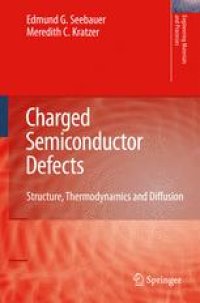
Ebook: Charged Semiconductor Defects: Structure, Thermodynamics and Diffusion
- Tags: Solid State Physics and Spectroscopy, Optical and Electronic Materials, Continuum Mechanics and Mechanics of Materials, Electronics and Microelectronics Instrumentation, Engineering Thermodynamics Transport Phenomena
- Series: Engineering Materials and Processes
- Year: 2009
- Publisher: Springer-Verlag London
- Edition: 1
- Language: English
- pdf
The technologically useful properties of a solid often depend upon the types and concentrations of the defects it contains. Not surprisingly, defects in semiconductors have been studied for many years, in many cases with a view towards controlling their behavior through various forms of "defect engineering." For example, in the bulk, charging significantly affects the total concentration of defects that are available to mediate phenomena such as solid-state diffusion. Surface defects play an important role in mediating surface mass transport during high temperature processing steps such as epitaxial film deposition, diffusional smoothing in reflow, and nanostructure formation in memory device fabrication.
Charged Semiconductor Defects details the current state of knowledge regarding the properties of the ionized defects that can affect the behavior of advanced transistors, photo-active devices, catalysts, and sensors.
Features:
- Group IV, III-V, and oxide semiconductors;
- Intrinsic and extrinsic defects; and,
- Point defects, as well as defect pairs, complexes and clusters.
A crucial reference for materials scientists, surface scientists, electrical engineers, and solid-state physicists looking to approach the topic of defect charging from an integrated chemical engineering perspective. Researchers and industrial practitioners alike will find its content invaluable for device and process optimization.
The technologically useful properties of a solid often depend upon the types and concentrations of the defects it contains. Not surprisingly, defects in semiconductors have been studied for many years, in many cases with a view towards controlling their behavior through various forms of "defect engineering." For example, in the bulk, charging significantly affects the total concentration of defects that are available to mediate phenomena such as solid-state diffusion. Surface defects play an important role in mediating surface mass transport during high temperature processing steps such as epitaxial film deposition, diffusional smoothing in reflow, and nanostructure formation in memory device fabrication.
Charged Semiconductor Defects details the current state of knowledge regarding the properties of the ionized defects that can affect the behavior of advanced transistors, photo-active devices, catalysts, and sensors.
Features:
- Group IV, III-V, and oxide semiconductors;
- Intrinsic and extrinsic defects; and,
- Point defects, as well as defect pairs, complexes and clusters.
A crucial reference for materials scientists, surface scientists, electrical engineers, and solid-state physicists looking to approach the topic of defect charging from an integrated chemical engineering perspective. Researchers and industrial practitioners alike will find its content invaluable for device and process optimization.
The technologically useful properties of a solid often depend upon the types and concentrations of the defects it contains. Not surprisingly, defects in semiconductors have been studied for many years, in many cases with a view towards controlling their behavior through various forms of "defect engineering." For example, in the bulk, charging significantly affects the total concentration of defects that are available to mediate phenomena such as solid-state diffusion. Surface defects play an important role in mediating surface mass transport during high temperature processing steps such as epitaxial film deposition, diffusional smoothing in reflow, and nanostructure formation in memory device fabrication.
Charged Semiconductor Defects details the current state of knowledge regarding the properties of the ionized defects that can affect the behavior of advanced transistors, photo-active devices, catalysts, and sensors.
Features:
- Group IV, III-V, and oxide semiconductors;
- Intrinsic and extrinsic defects; and,
- Point defects, as well as defect pairs, complexes and clusters.
A crucial reference for materials scientists, surface scientists, electrical engineers, and solid-state physicists looking to approach the topic of defect charging from an integrated chemical engineering perspective. Researchers and industrial practitioners alike will find its content invaluable for device and process optimization.
Content:
Front Matter....Pages i-xiv
Introduction....Pages 1-4
Fundamentals of Defect Ionization and Transport....Pages 5-37
Experimental and Computational Characterization....Pages 39-61
Trends in Charged Defect Behavior....Pages 63-72
Intrinsic Defects: Structure....Pages 73-130
Intrinsic Defects: Ionization Thermodynamics....Pages 131-194
Intrinsic Defects: Diffusion....Pages 195-232
Extrinsic Defects....Pages 233-289
Back Matter....Pages 291-294
The technologically useful properties of a solid often depend upon the types and concentrations of the defects it contains. Not surprisingly, defects in semiconductors have been studied for many years, in many cases with a view towards controlling their behavior through various forms of "defect engineering." For example, in the bulk, charging significantly affects the total concentration of defects that are available to mediate phenomena such as solid-state diffusion. Surface defects play an important role in mediating surface mass transport during high temperature processing steps such as epitaxial film deposition, diffusional smoothing in reflow, and nanostructure formation in memory device fabrication.
Charged Semiconductor Defects details the current state of knowledge regarding the properties of the ionized defects that can affect the behavior of advanced transistors, photo-active devices, catalysts, and sensors.
Features:
- Group IV, III-V, and oxide semiconductors;
- Intrinsic and extrinsic defects; and,
- Point defects, as well as defect pairs, complexes and clusters.
A crucial reference for materials scientists, surface scientists, electrical engineers, and solid-state physicists looking to approach the topic of defect charging from an integrated chemical engineering perspective. Researchers and industrial practitioners alike will find its content invaluable for device and process optimization.
Content:
Front Matter....Pages i-xiv
Introduction....Pages 1-4
Fundamentals of Defect Ionization and Transport....Pages 5-37
Experimental and Computational Characterization....Pages 39-61
Trends in Charged Defect Behavior....Pages 63-72
Intrinsic Defects: Structure....Pages 73-130
Intrinsic Defects: Ionization Thermodynamics....Pages 131-194
Intrinsic Defects: Diffusion....Pages 195-232
Extrinsic Defects....Pages 233-289
Back Matter....Pages 291-294
....